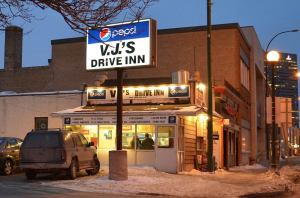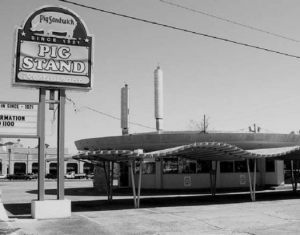


Back in September 2014, I’d never have guessed some 80,000 views and 2½ years later, how often I’d have written about food, especially fast food joints and other greasy spoons in Canada and the United States. I’m not quite sure what I thought I was going to be writing about, but I don’t remember food being on my composing radar for blog posts. Premillennial dispensationalism? The Rapture? Young Earth Creationism? Spiritual Warfare? Petrus Romanus? Prophecy of St. Malachy or Prophecy of the Popes? Any and all things Catholic? Sure, all of these and more, some pretty arcane and from the fringe of the respectable-thinking universe. But food? Who’d a thunk it?
Admittedly, I had written on occasion about food, especially fast food, prior to venturing forth with soundingsjohnbarker (https://soundingsjohnbarker.wordpress.com/) but not that often. Mainly if it involved a road trip from Southern Ontario to New England or vice-versa that wound up taking me to my favourite Red Barn, up in the Adirondacks in Troy, New York, or something got me thinking about high school back in Oshawa, Ontario and memories of Mother’s Pizza and Pepi’s Pizza. That sort of thing.
Just taking a quick look here, it looks like I’ve become an insatiable lowbrow fast food blogger who dreams of being to blogging what Guy Fieri of Diners, Drive-Ins and Dives is to TV. And that’s just looking for headlines that trumpet food, not so much others posts that mention food either in a secondary or passing fashion, overshadowed by a main non-food story. Last year I wrote about Glenview, Illinois-based Family Video (https://soundingsjohnbarker.wordpress.com/2016/01/17/who-shot-the-video-store-and-how-did-glenview-illinois-based-family-video-survive-to-thrive-and-still-rent-movies-and-now-sell-pizza/), which continues to survive and thrive and still rent movies, but also mentioned how they now sell pizza made in their video stores from Marco’s Pizza of Toledo, Ohio. Marco’s Pizza, founded in 1978 by Pasquale “Pat” Giammarco, is one of the fastest-growing pizza franchise operations in the United States. The Toledo-based delivery pizza franchisor opened 116 stores in 2015. Pizza is a $46- billion market in the United States that continues to grow at a rate of about one to two per cent per year.
In a similar vein, I’ve written a couple of times about the Burntwood Curling Club’s monthly, from November to April anyway, fundraising pickerel fish fry, now in its third season, to bring in some revenue at $20 a plate for the older crowd and $10 a plate for those 12 and under, with proceeds going towards what it cost to replace the club’s aging ice plant, a big ticket six-figure item for curling clubs. The last fish fry of the season is set for Monday, April 3 in the upstairs club lounge from 5 p.m. to 7:30 p.m. The fish fry involves club volunteers cooking about 50 pounds per fish fry of fresh pickerel, also known as walleye, from the commercial fish packing station in Wabowden. Pickerel is the most valuable commercial fish catch in Manitoba, with an average value of about $20 million per year, which is about 70 per cent of the landed value of all species, and comprise more than 40 per cent of commercial fish production in the province by weight. Am I writing primarily about curling or pickerel? I suppose some of both really, but I know a bit more about pickerel. Jeanette and I are looking forward this spring and summer to marking a decade fishing together off the dock for pickerel at Paint Lake Marina!
I’ve written here and elsewhere about driving a Plymouth Duster to deliver for Mother’s Pizza Simcoe North in Oshawa during my last spring in high school for $2.65 per hour – plus tips (https://soundingsjohnbarker.wordpress.com/2014/09/15/a-taste-for-yesterday-mothers-pizza-and-pepis-pizza/). Mother’s was an iconic Canadian pizza parlour chain from the 1970s – with its swinging parlour-style doors, Tiffany lamps, antique-style chairs, red-and-white checked gingham tablecloths, black-and-white short silent movies shown on a screen for patrons waiting for their meal to enjoy, root beer floats and pizzas served on silver-coloured metal pedestal stands.
Maybe we all just love food, no?
In Winnipeg, we have V.J.’s Drive Inn at at Broadway and Main with its overstuffed double chili cheese dogs, greasy spoon certified cheeseburgers, golden fries and chocolate milkshakes, all for the more discerning among the Fort Garry Hotel clientele methinks.
And speaking of chili dogs: should you ever find yourself down in Durham, North Carolina, you can’t go wrong enjoying a meal at The Dog House, locally owned and in business in Durham since 1970, and serving up an assortment of Bull-Dogs, Boxer Dogs, Collie Dogs, Hound Dogs, Puppy Dogs, Ol’ Yallows and the like.
Living in North Carolina was where I developed tastes for chili dogs, deep-fried cornmeal-batter Hushpuppies, pork barbecue and fat back, cracklins and wash pot pork rinds, while prudently not losing said tastes by overdoing it with low-density lipoproteins (LDL) cholesterol testing at nearby Duke University Medical Center, although I visited the world-class medical facility for other ailments on occasion.
The Dog House says its chili is made from a family recipe with pure beef, and no beans, soy or other fillers; just a blend of secret spices and 47 years of experience.
As for the slaw, it is “not too sweet and not too spicy,” and always freshly made.
But closer to home, when you’re appetite is a bit larger than a sausage dog or one of its cousins, my pick is Lovey’s BBQ in St. Boniface for hand trimmed briskets, pork shoulders and ribs. Yum!
Sometimes you get to combine your writing interests, say about Catholicism and food, as I did in “Catholic cooking: From Pope Francis’ love for Buenos Aires pizzerias to Father Leo Patalinghug, the TV show Filipino ‘Cooking Priest’” (https://soundingsjohnbarker.wordpress.com/2015/03/15/catholic-cooking-from-pope-francis-love-for-buenos-aires-pizzerias-to-father-leo-patalinghug-the-tv-show-filipino-cooking-priest/)
I combined Catholicism and food on a few other occasions as well: In “‘Make mine halibut, please’: Fish-and-chips-Catholic-on-Friday” (https://soundingsjohnbarker.wordpress.com/2014/11/07/make-mine-halibut-please-fish-and-chips-catholic-on-friday/) I wrote that until Blessed Pope Paul VI proclaimed Paenitemini (Apostolic Constitution On Penance) on Feb. 17, 1966, which allowed episcopal conferences to permit Catholics in their jurisdictions to substitute some other penitential practice aside from abstaining from meat on Fridays. Catholics had been eating fish on Friday under an edict in force in the universal church since Pope Saint Nicholas 1, also known as Saint Nicholas the Great, in 851. With the exception in Canada of Ash Wednesday and Good Friday in accordance with the prescriptions of Canon 1253, proclaimed in 1983. Fridays are days of abstinence, but Canadian Catholics can substitute special acts of charity or piety on this day.
No need to feel too sorry though for us fish eaters for having to forgo meat on Fridays from 851 to 1966. We made up for it on an annual basis on “Fat Tuesday,” which fell on Feb. 28 this year. Fat Tuesday. Mardi Gras. Máirt Inide. Dydd Mawrth Ynyd. Fastnacht. Fastelavn. Sprengidagur. Güdisdienstag. Vastlapäev. Užgavėnės. Fettisdagen. Laskiainen. Shrove Tuesday. Call it what you will, but we made sure we ate – and ate big and ate rich – on this moveable feast, based on the lunar cycles of the moon – the last day of Shrovetide before the penitential season of Lent begins on Ash Wednesday, which is its colloquial name. Dating to the A.D. 900s, the official name is the Day of Ashes. Come to think of it, even though we can eat meat on Fridays now outside of Lent, we remain fond of Shrove Tuesday.
“If smell and sound are important to Catholics, so, too, taste,” I wrote in a blog post headlined “With our O antiphons, Smoking Bishops and ‘sinful servants’ we are the Church Militant on Earth.” I noted that we had borrowed the “Smoking Bishop,” a mulled wine wassail, “in a spirit of ecumenical breaking of bread at table” from our “Anglican or Episcopalian brothers and sisters, particularly Charles Dickens, a heterodox Anglican if ever there was one, who wrote A Christmas Carol after he journeyed to Lancashire in the summer of 1843 to see for himself how life was lived in the industrial north of England. He completed the book that fall in six weeks and the book was published on Dec. 19, 1843 (https://soundingsjohnbarker.wordpress.com/2014/12/18/with-our-o-antiphons-smoking-bishops-and-sinful-servants-we-are-the-church-militant-on-earth/).
“A merry Christmas, Bob!” said Scrooge, with an earnestness that could not be mistaken, as he clapped him on the back. “A merrier Christmas, Bob, my good fellow, than I have given you, for many a year! I’ll raise your salary, and endeavour to assist your struggling family, and we will discuss your affairs this very afternoon, over a Christmas bowl of Smoking Bishop, Bob!”
It is in that spirit we offer you this recipe for a Smoking Bishop, courtesy of Cedric Dickens, a great-grandson of Charles Dickens, published in his 1988 book, Drinking with Dickens:
Smoking Bishop
6 Clementines
1/2 C sugar
30 cloves
8 C moderately sweet red wine
1 bottle ruby port
Bake the oranges in a medium oven for about 20 minutes. Stick cloves into the oranges and then put them into a large bowl. Pour the wine over them and add the sugar. Cover and leave in a warm place for 24 hours. Squeeze the juice from the oranges and mix it with the wine. Add the port and heat the mixture in a pan. Do not boil. Serve hot.
And you can be pretty sure that while I might not post about it on soundingsjohnbarker, I’m quite likely to put in a bit of a plug on my Facebook page at least for annual Grilled Cheese Sandwich Day come Wednesday, April 12. I’ve done so for the last two years.
Melting cheese on top of bread is a culinary concept that has been around since the time of Ancient Rome, but modern grilled cheese sandwiches, as we know them, didn’t become popular until the 1920s. Due to the ready availability of cheese and sliced bread for the average consumer by the early 20th century, they became an American staple, but a connoisseur’s love for grilled cheese sandwiches also spread around the world.
Thanksgiving, of course, gives me a change to give holiday nod to turkey, such as in this piece, “Mouthwatering American Thanksgiving recipes correction in the New York Times and other pardonable acts” (https://soundingsjohnbarker.wordpress.com/2014/11/27/mouthwatering-american-thanksgiving-recipes-correction-in-the-new-york-times-and-other-pardonable-acts/):
“Correction: November 26, 2014
“An article last Wednesday recommending a Thanksgiving dish from each state, with a recipe, contained numerous errors.
“The recipe from Connecticut, for quince with cipollini onions and bacon, omitted directions for preparing the quince. It should be peeled, cored and cut into 1-inch chunks. An illustration with the West Virginia recipe, for pawpaw pudding, depicted a papaya — not a pawpaw, which is correctly depicted above. The introduction to the recipe from Arizona, for cranberry sauce and chiles, misstated the origin of Hatch chiles. They are grown in New Mexico, not in Arizona.
“The introduction to the Delaware recipe, for du Pont turkey with truffled zucchini stuffing, referred incorrectly to several historical points about the Winterthur estate. It was an ancestral home of the du Pont family, not the sole one; it was established in 1837, not in 1810; the house was completed in 1839, not in 1837. The introduction also misstated the relationship of Pauline Foster du Pont to Eleuthère Irénée du Pont. Pauline was the wife of Mr. du Pont’s grandson, not his daughter-in-law.
And I wouldn’t be much of a former New Englander, if after enjoying a “blue” rare steak, I didn’t enjoy scarfing down some super premium ice cream, like Steve’s Ice Cream, named after Steve Herrell, as it was in the early 1980s at the original location on Elm Street in Davis Square in Somerville, Massachusetts, or Ben & Jerry’s Homemade, Inc., which got its its start in a renovated gas station at the corner of St. Paul and College streets in Burlington, Vermont. In 1980, they were showing movies on summer Saturday nights on an outside wall of the gas station, I remember.\
Burgers have been the continuing jackpot for my food entries, however, which may not surprise many. What might surprise you, however, is the relatively big numbers (outpacing anything I’ve written on Thompson city council, can you believe it?) has been for two posts on two defunct American burger chains, both of which also operated for a time in parts of Canada, particularly in the 1970s.
Apparently former employees of the two burger chains and hungry aficionados who remember them fondly, salivate, or so it seems, to a helping of words on the Red Barn and Burger Chef, gone, but never forgotten.
Both stories get read pretty much daily somewhere in the world and “Red Barn, Big Barney and the Barnbuster” (https://soundingsjohnbarker.wordpress.com/2014/09/13/red-barn-big-barney-and-the-barnbuster/) was published here back on Sept. 13, 2014, while “Burger Chef: The story of the greatest might-have-been in the history of the fast food business” (https://soundingsjohnbarker.wordpress.com/2016/03/13/burger-chef-the-story-of-the-greatest-might-have-been-in-the-history-of-the-fast-food-business/) appeared originally on March 13, 2016.
You can also follow me on Twitter at: https://twitter.com/jwbarker22
 A&W is credited for popularizing onion rings after adding them to their menu in the 1960s. I make my own contribution to their continued popularity here in Thompson, Manitoba many a Wednesday evening while stopping by my local A&W for a $5.25 order of onion rings on my way between the University College of the North (UCN) Thompson campus library and Quality Inn & Suites Thompson. I could call it a pandemic takeout indulgence perhaps except for the fact I’ve been doing it since around 2015.
A&W is credited for popularizing onion rings after adding them to their menu in the 1960s. I make my own contribution to their continued popularity here in Thompson, Manitoba many a Wednesday evening while stopping by my local A&W for a $5.25 order of onion rings on my way between the University College of the North (UCN) Thompson campus library and Quality Inn & Suites Thompson. I could call it a pandemic takeout indulgence perhaps except for the fact I’ve been doing it since around 2015.


